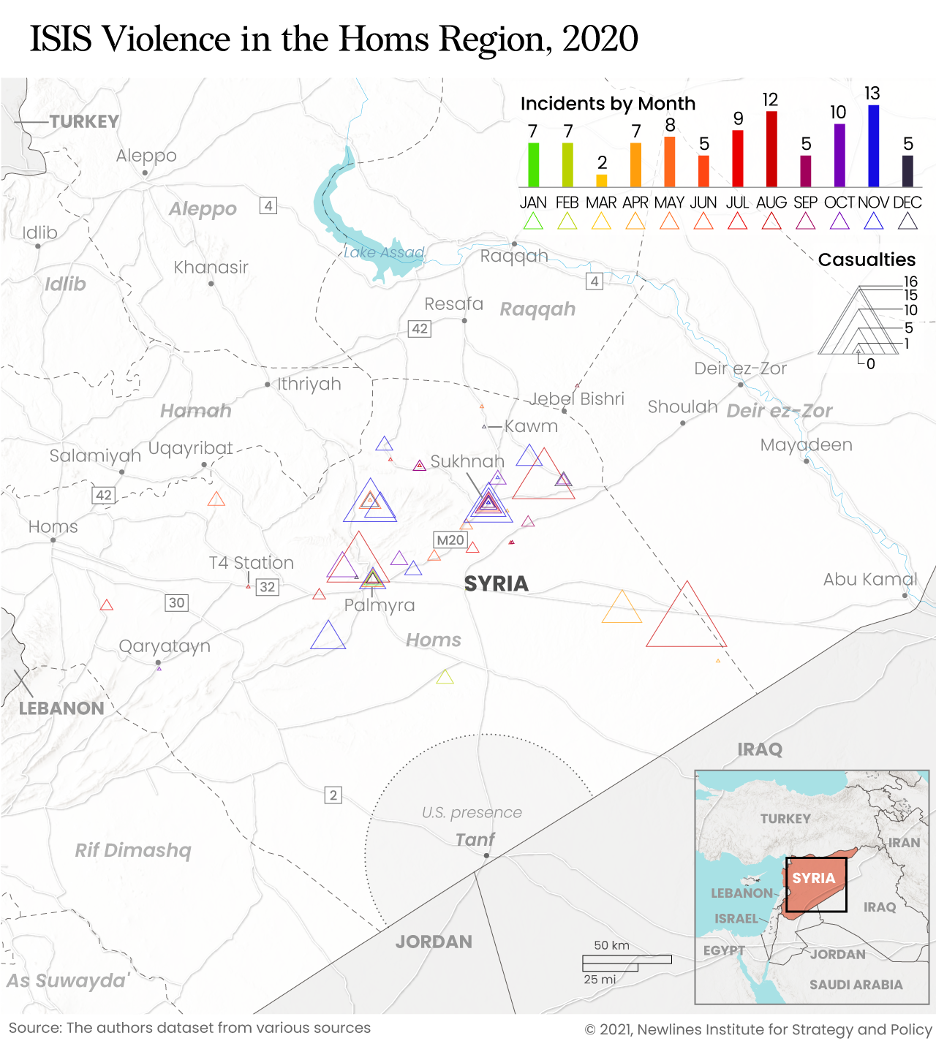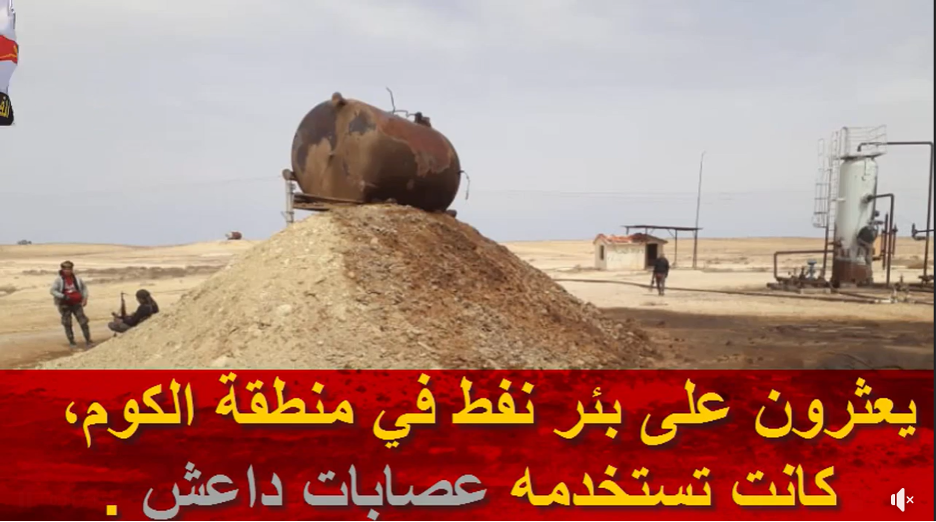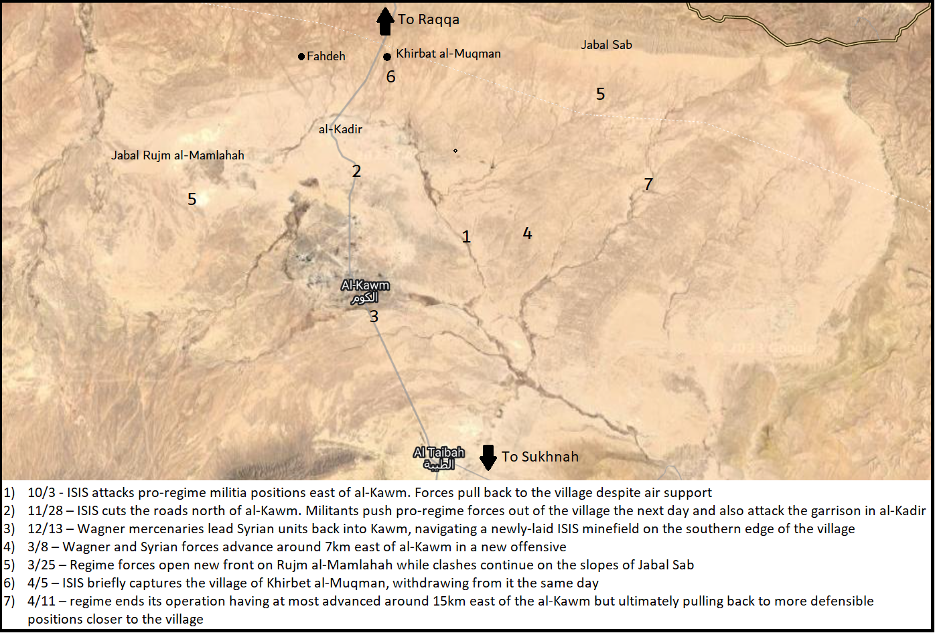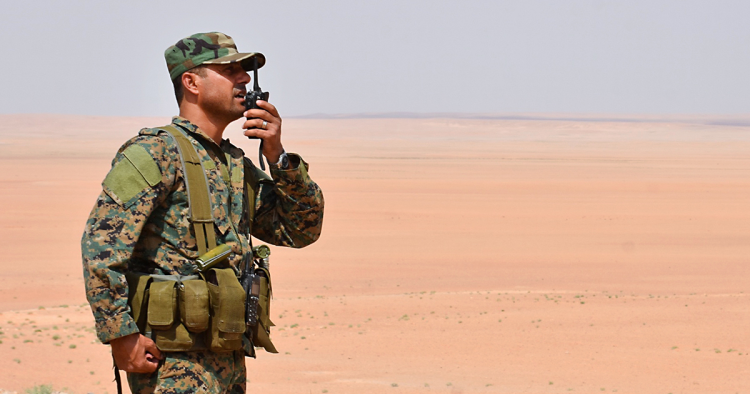It has been an accepted fact that ISIS ceased being a territory-controlling entity in Syria after its March 2019 defeat in the town of Baghouz. Yet it is perhaps time to reevaluate this perspective on the group and its insurgent trajectory in the country. While recent massacres of civilians in central Syria have refocused some international attention on the desert region, known as the Badia, the renewed widespread battles between militants and regime security forces that have occurred in parallel to these attacks have gone unnoticed. The most significant of these was the recent battle for the village of al-Kawm between ISIS cells and Syrian military units led by the Russian private military company Wagner Group. The fighting has, as of the time of this writing, ended in a stalemate, with ISIS militants retaining control of the mountains overlooking the village.
This is not the first time ISIS has carved out pieces of the Badia for its own. The ebb and flow of the group’s five-year insurgency has resulted in recurrent, though temporary, captures of empty villages manned by pro-Damascus security forces. Meanwhile, the group has also kept control of wadis and unsettled land throughout the Badia that the regime has been unable to reclaim since it first drove ISIS out of central Syria’s urban centers in 2017. Chief among these are Wadi Doubayat, south of Sukhnah and the site of the Feb. 17 massacre of truffle hunters that made international headlines, and the countryside around the abandoned village of Faydat Bin Muwaynah, west of Mayadeen. These regions and others like them have served as bases of operations for ISIS, enabling it to rebuild its fighting cells, train young recruits from central and northeast Syria, and stage attacks across the region.
Al-Kawm always in the crosshairs
ISIS first began recapturing villages in central Syria in mid-2020. These first attacks paradoxically took place in eastern Hama — a region that had been free from ISIS activity since a deal struck with the regime in October 2017 allowed the remaining militants to move through regime lines and attack rebel forces in Idlib. In June 2020, ISIS cells launched a surprise attack deep within what was then considered secure regime territory, capturing two villages less than 10 miles from the city of Sa’an. Russian and Syrian warplanes and ground forces dislodged the militants after 48 hours, but four months later a group of 50 ISIS fighters was able to capture another string of villages further to the north. Militants were allegedly dislodged after three days of fighting when the former Syrian minister of defense (who hails from the area) arrived with additional forces. However, a security officer with knowledge of the fighting told the author at the time that the pro-regime National Defense Forces (NDF) tasked with holding these villages never reestablished a presence in the area. Two months later, fighting erupted once more as ISIS cells were discovered to still be in control of several nearby villages. ISIS had forcefully asserted its presence throughout central Syria, not just as a typical hit-and-run insurgency but as a group once again capable of striking and seizing small settlements.
While these operations demonstrated ISIS’s renewed capabilities, the group ultimately lacked the strength to hold onto these villages on the periphery of core regime territory. The more significant and strategically important territorial battles have occurred deeper in the Badia, closer to what could be considered the “core” of ISIS’s stomping grounds, around the village of al-Kawm in eastern Homs. Al-Kawm — long empty of civilians — is the largest settlement straddling the highway that connects the M20 (linking Homs to Deir ez-Zor) with the city of Raqqa. The village also sits in a valley along the mountain range connecting key parts of west Deir ez-Zor, southern Raqqa, east Homs, and east Hama — a key transit route for ISIS cells moving through central Syria and to and from northeast Syria. The village is therefore an important position to both secure regime military and commercial traffic and to interdict roving ISIS cells, and has thus been a target of ISIS activity since the beginning of its insurgency. ISIS forces marked their return to the al-Kawm countryside in April 2019 by ambushing a special forces unit led by Col. Nader Saqr, a battalion commander and head of the al-Kawm sector, killing the colonel and more than a dozen soldiers.

Two years later ISIS had become strong enough to target the village itself, ushering in a new era of back-and-forth fighting for control over the area that continues until today. By January 2021 regime forces no longer had a permanent presence in the countryside around the village. In April 2021 militants killed the new commander of the al-Kawm sector and expelled regime forces from the village itself. ISIS fighters withdrew from the village the next day, but maintained control of the mountains just to the east, where they proceeded to ambush and repel regime advances for the next month. These battles also marked the first use of Russian airpower in the al-Kawm region since 2017, which reportedly proved critical in blunting and partially rolling back ISIS advances. Militants and security forces would skirmish around the village for the rest of the year, with operations being largely conducted by local NDF and Liwa al-Quds fighters supported by elements of the army’s 4th Division.
In February 2022 Russia’s Wagner Group arrived on the front. The group has its headquarters in the nearby city of Palmyra, whose defenses it oversees, and has fought ISIS (and committed brutal crimes) in eastern Homs for nearly 10 years. While around 1,200 Wagner personnel are currently deployed to Palmyra, the group has, for unknown reasons, never sent more than a few dozen to assist in operations around al-Kawm. Throughout most of 2022 ISIS cells focused their attacks in the area on the northern flank of al-Kawm, particularly around the hamlets of al-Kadir, Fahdeh, and Khirbat al-Muqman, which all sit along the highway at the Raqqa-Homs administrative border. Attacks in January, March, and September sought to expel security forces from these hamlets and cut supply lines between Raqqa and al-Kawm. The most significant battles occurred in late March, when militants engaged in four days of sustained fighting with multiple regime units across the front. Regime fighters reported an extremely rare use of an ISIS anti-tank guided missile (ATGM) when militants captured a position near Fahdeh from which they were able to loot quantities of weapons, ammunition, and medicine. Following the conclusion of the fighting and ISIS’s withdrawal, regime forces extended their patrols for the first time into the neighboring plains and found an oil well ISIS had apparently been operating for years only a few miles from al-Kadir.

ISIS challenges Wagner
The latest round of battles for al-Kawm began in October 2022, when fighting erupted in the hills east of al-Kawm between ISIS and local NDF and Liwa al-Quds units. Despite the use of Russian air support, regime troops were forced to withdraw from their outposts and consolidate in the village, where a small group of Wagner mercenaries arrived to assist. In late November, ISIS cells took the initiative and launched an assault on the village itself. Militants first cut the roads north of al-Kawm, then pushed both south and north, forcing regime troops out of the village while also attacking the garrison in al-Kadir. ISIS held al-Kawm from Nov. 29 until Dec. 13, when regime forces under the command of Wagner mercenaries and supported by Russian attack helicopters flying out of Tabqa Airbase finally pushed back into the village. According to a local source, the operation had been delayed due to a fuel shortage for regime forces based out of Sukhnah, and was only possible when another army unit was able to send a shipment of fuel from the city of Homs.
By this point Wagner had taken full command of military operations on the al-Kawm front and began deliberating on a new operation to expand the security perimeter from the village into the ISIS-held mountains to the east and northwest. Fuel concerns persisted, as did a desperate need for air support. Yet, for unknown reasons, the Russian air force has ceased operating on this front since January. It is possible the recent tensions in Ukraine between the Russian Ministry of Defense and Wagner are impacting cooperation in Syria, or that the Russian military is taking a more cautious approach to the use of its critical but limited helicopter force, fearing that it cannot replace or repair lost or damaged airframes.
Nevertheless, Wagner launched a new operation in the first week of March. Around 50 Belarussian Wagner members who recently arrived in Syria are commanding a large Syrian force of Syrian NDF and 11th Division soldiers, supported by fresh War College graduates and several tanks from the 4th Division’s 40th Brigade. Language barriers, incompetence and unprofessionalism from the Wagner mercenaries, and the lack of air support compounded to make a difficult mission near impossible. Regime forces made some early gains in mid-March, advancing several miles east and establishing frontline outposts. Regime forces also captured several ISIS militants at this time, reportedly executing at least three of them.
ISIS cells continued to push back and regime forces have been unable to maintain any of their frontline positions. In late March, Wagner opened a new front on the northwest axis of al-Kawm. The main objectives of the battle were now Mount Rujm al-Mamlahah, six miles west of al-Kawm, and Mount Sab, seven miles to the northeast. Yet ISIS cells also conducted a new offensive action, briefly seizing the village of Khirbat al-Muqman on April 6. The escalating fighting the last week of March and first week of April left at least 25 Syrian soldiers killed and wounded and at least one Wagner mercenary wounded (though for the most part Wagner has reportedly avoided any frontline combat).

ISIS seems to have deployed a significant number of fighters to the front. Fighting groups range from five to 25 men and ambushes often begin with one group engaging regime forces directly while another moves along their flanks. Such coordinated and sustained battles centered around the two mountains, which are more than 12 miles apart, suggests that well over 100 ISIS militants are involved. According to those in contact with regime fighters on the front, ISIS cells are using only small arms and improvised explosive devices, relying on their years of experience in these mountains and creek beds to draw regime forces into ambushes and mine fields, the latter of which has proven critical to impeding the advance of Syrian army scouts.
A few Syrian jets finally arrived on April 9 and conducted limited airstrikes on suspected ISIS positions, but ultimately proved too little to tip the scales. On April 11 the regime ended its operation, with both mountains still in the hands of ISIS and the plains around al-Kawm considered no-man’s land. The senior 4th Division commander for the area has reportedly assessed the operation to be too dangerous without more manpower and air support.
Stemming the flow of new recruits
The most recent battle for al-Kawm stands as a stark reminder that for all the discussion of the countless murders of Syrian civilians in central Syria, ISIS has also steadily increased the ferocity of its insurgency against regime security forces since January. As this author has consistently argued, much of the reduction in ISIS activity in central Syria in 2022 appeared to be self-driven given that it came amid an equal lull in regime anti-ISIS operations. ISIS operational trends over past years appear to show a clear tendency toward caution, picking battles that are likely to result in few to no ISIS human or material losses and quickly withdrawing in the face of regime counter-attacks. Therefore, the fact that ISIS has not only escalated its activity recently but also stood its ground against a regime counter-offensive suggests the group believes itself to be in a position of strength now — at least in the Badia.
The most likely reason for this is that ISIS has managed to integrate a new cohort of young recruits into its active cells. It has been well established that central Syria has for years served a key role in holding and training young Syrian recruits. Many of these young boys come from northeast Syria, both recruited locally and smuggled out of overcrowded prisons run by the U.S.-backed Syrian Democratic Forces (SDF). For example, one of the militants regime forces captured outside al-Kawm was a 15 year old from Deir ez-Zor. As MEI’s Charles Lister has written, these prisons in northeast Syria hold thousands of veteran ISIS fighters who, due to a lack of both an institutionalized judicial process and resources, are being kept alongside thousands more young boys either linked to or suspected of being linked to ISIS. This crisis is no longer the “ticking time bomb” many have described in the past, it has already begun. The slow and steady trickle of new and veteran ISIS recruits being smuggled out of these prisons was compounded by the February 2022 prison break in Hasakah, in which ISIS succeeded in freeing around 300 prisoners, including senior figures, many of whom successfully made their way to central Syria.
ISIS has a plan for an eventual resurgence. The group has been laying the groundwork to rebuild, refinance, and recruit the next generation of fighters across northeast and central Syria since 2019. It controls territory in central Syria and retains the capacity to not only challenge, but seize key strategic points from the Syrian regime. ISIS does not yet have the will or capacity to permanently hold these villages, however. There is still time to develop and implement a comprehensive policy to address the prisoner dilemma in northeast Syria while also focusing resources on improving the SDF’s approach in Deir ez-Zor and better securing the SDF-regime frontline in order to limit the flow of ISIS members between the two regions. What cannot be done is to continue to ignore the critical role central Syria plays in ISIS’s long-term plans and its growing strength under an impotent regime in Damascus.
Gregory Waters is a Non-Resident Scholar at the Middle East Institute, a consultant for the International Crisis Group, and a research analyst at the Counter Extremism Project. You can follow him on Twitter @GregoryPWaters.
Photo by GEORGE OURFALIAN/AFP via Getty Images
The Middle East Institute (MEI) is an independent, non-partisan, non-for-profit, educational organization. It does not engage in advocacy and its scholars’ opinions are their own. MEI welcomes financial donations, but retains sole editorial control over its work and its publications reflect only the authors’ views. For a listing of MEI donors, please click here.













